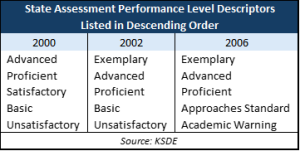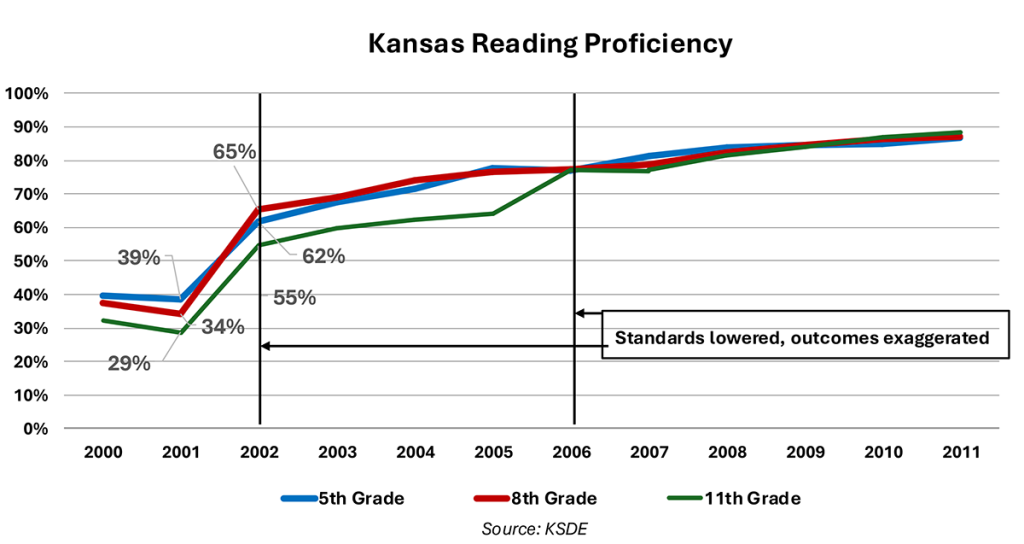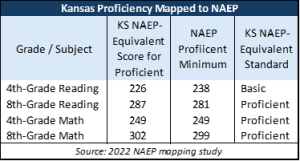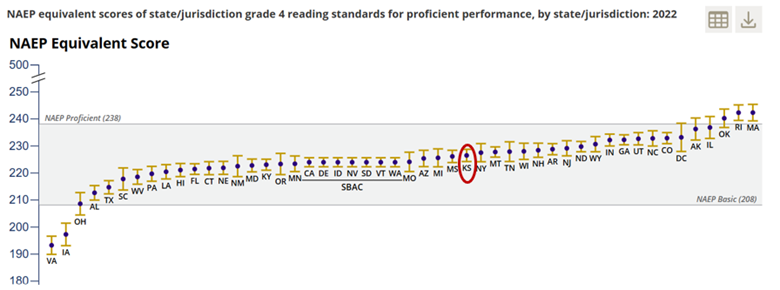The Kansas State Department of Education (KSDE) has been slow-rolling proposed changes to proficiency standards on the state assessment test students are taking before the end of this school year. KSDE is proposing new performance level descriptors (PLDs) and the cut scores that will determine how the test results are qualified, which is like setting an A through F grading scale (e.g.,90-100 is an A).
The first clue that KSDE may be trying to get the State School Board to approve lower standards is that the cut scores will be set after the test results are reviewed. That at least gives the appearance of grading on a curve to normalize outcome distribution, where pre-determined percentages of students will get As, Bs, Cs, Ds, and Fs. Adjusting test results inflates outcomes; it is a disservice to students, and it would not be the first time that KSDE has reduced standards to inflate student performance.
The first time (that we know of) goes back to when President George W. Bush signed the No Child Left Behind Act in 2001. The goal of NCLB was to have 100% of public school students proficient by 2014. Of course, everyone knew that was impossible, so Congress helped state education departments create the illusion of proficiency by letting each state develop its own definitions, and predictably, standards plummeted.
As documented in our 2012 report “Removing Barriers to Better Public Education,” KSDE and the State Board of Education took advantage of the opportunity to redefine proficiency by creating new standards in 2002. It was an illusion that would make David Copperfield proud.
The 2002 standards replaced those that had been in effect since 2000. The performance categories in 2000 and 2001 were Advanced, Proficient, Satisfactory, Basic, and Unsatisfactory. KSDE changed the performance categories in 2002 to Exemplary, Advanced, Proficient, Basic, and Unsatisfactory. Proficient went from being the second-highest category to the third-highest category.
 Department officials confirm that the same assessment was given in 2000 and 2002; they also acknowledge that the five levels of cut scores remained intact.[1] The only thing that changed was the labels. “Advanced” was changed to “Exemplary,” “Proficient” was renamed “Advanced,” and what was previously considered “Satisfactory” was suddenly “Proficient.”
Department officials confirm that the same assessment was given in 2000 and 2002; they also acknowledge that the five levels of cut scores remained intact.[1] The only thing that changed was the labels. “Advanced” was changed to “Exemplary,” “Proficient” was renamed “Advanced,” and what was previously considered “Satisfactory” was suddenly “Proficient.”
Lowering the standards led to a startling jump in proficiency levels.
Reading proficiency for 5th-grade students went from 39% in 2001 to 62% in 2002. The rate nearly doubled for 11th-grade students, from 29% to 55%.

There is also good reason to believe that standards were further reduced in 2006, when KSDE created a new assessment, cut scores, and revised performance categories with new definitions. The U.S. Department of Education’s 2009 mapping study compared the Kansas cut score for proficiency with the one it used on the National Assessment of Educational Progress (NAEP), concluding that the Kansas definition of proficient equated to Below Basic on NAEP.
 Kansas reported that 85% of 8th-graders were proficient in reading on the 2013 state assessment, but only 36% were considered proficient by the national standard. KSDE changed the state assessment and related elements again in 2015, but the standards were much higher this time. In fact, the 2022 NAEP mapping study says the Kansas version of proficient equates to proficient on NAEP.
Kansas reported that 85% of 8th-graders were proficient in reading on the 2013 state assessment, but only 36% were considered proficient by the national standard. KSDE changed the state assessment and related elements again in 2015, but the standards were much higher this time. In fact, the 2022 NAEP mapping study says the Kansas version of proficient equates to proficient on NAEP.
The minimum NAEP score for proficient in 8th-grade reading is 281, and USDE gives Kansas a NAEP-equivalent score of 287 for the state proficiency standard. For reference, ten points on the NAEP is considered a year’s worth of learning. That puts the Kansas proficiency standard for 4th-grade reading more than a year behind at 12 points below the minimum score for NAEP proficient, but about a half year ahead of the minimum for 8th-grade reading.
Kansas is exactly at the minimum cut score for proficient in 4th-grade math and three points above the minimum for 8th-grade math.

Naturally, the higher state standard for 8th-grade reading produced a much lower proficiency level. Instead of a 49-point gap in 2013, the gap was only five points in 2015 (30% state vs. 35% NAEP). The most recent 2024 results have only a three-point gap (22% state vs. 25% NAEP).
However, the state standard for 4th-grade reading equates to just mid-range Basic.

The takeaway for State School Board members is that the new standard for 4th-grade reading should be raised, and the rest cannot be reduced.
KSDE officials, now proposing new PLDs and cut scores, present state school board members with multiple challenges.
Challenges facing state school board members with new standards
There is no requirement for KSDE to change the state assessment, but a previous State School Board approved spending millions of dollars to have a team at the University of Kansas create a new test. In the past, a new assessment test came with a warning that results cannot be compared to results from a previous assessment. That begs whether the motivation for unnecessarily spending money on a new test is to render past results irrelevant.
Last year, the Legislature prepared achievement targets on the Kansas Blueprint for Literacy without knowing the assessment was changing. The goals are to go from 33% proficient in reading and math to 50% by 2033 and to have the percentage of students below grade level (Level 1 on the test) drop from 32% to 10%. It will be interesting to see how (or even if) progress can tracked going forward.
Challenge #1 for State School Board members is ensuring the new cut scores equate to proficiency on NAEP. They should insist on written documentation of the process KSDE will use to do so before they see the test results.
Challenge #2 is forcing KSDE to be honest about grade-level performance. KSDE insists that the current assessment does not indicate if any students are below grade level, with the implausible rationale that the test only measures grade-level performance. Commissioner Randy Watson recently said, “A lot of research says if you’re not at that grade level by the time you hit third grade, it’s really hard to catch up, and most do not,” If the state assessment doesn’t indicate which students are below grade level, how are schools supposed to know who needs remedial training to catch up?
Challenge #3 will be to ensure that questions on the new test will not contain any DEI (diversity, equity, inclusion) or SEL (social-emotional learning) elements. Students should be tested on their knowledge of math, science, and reading skills without subtle indoctrination of how they feel or should think about societal issues. Board members should insist on being allowed to read all the questions before signing off on anything related to the new test.
Unfortunately, the Kansas Department of Education has a history of not being completely honest with its board members, legislators, and the general public. Just this year, we’ve documented inaccurate and misleading comments on student outcomes, the constitutionality of school funding, cash reserves, performance level descriptors, and accrediting districts that knowingly violate the law on how at-risk funding is to be spent solely on above-and-beyond services.
The stakes are too high, and the State School Board cannot afford to take KSDE officials’ word on any of this.
_____________
[1] Email received May 1, 2012, from Kansas Commissioner of Education, Dr. Diane DeBacker, copy in author’s possession.





